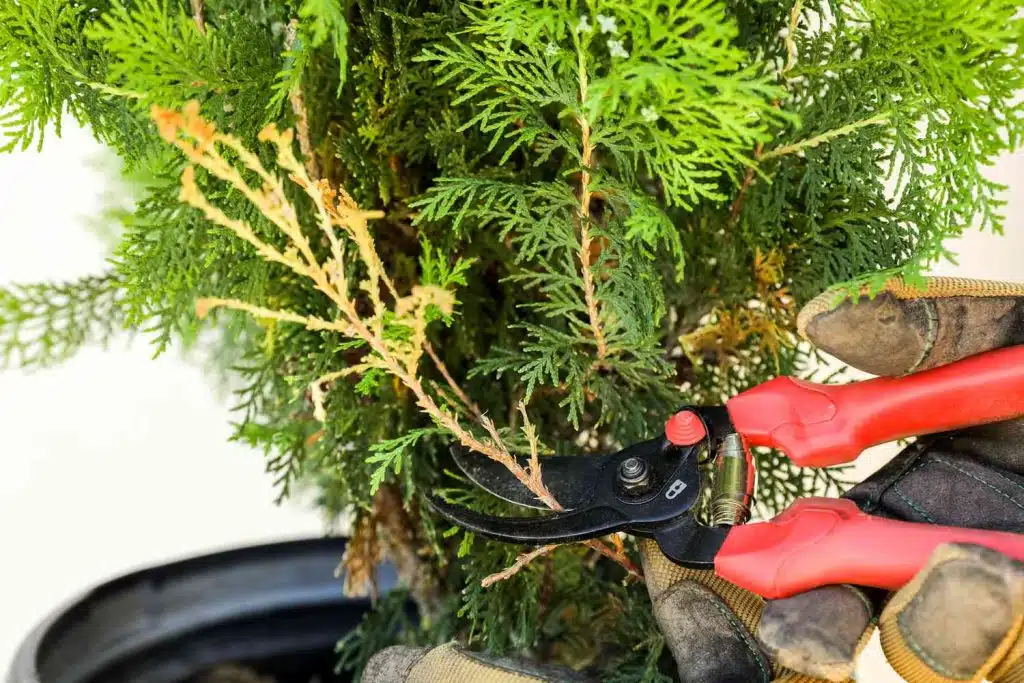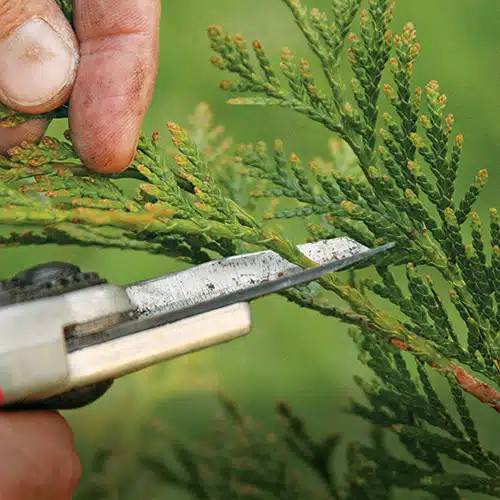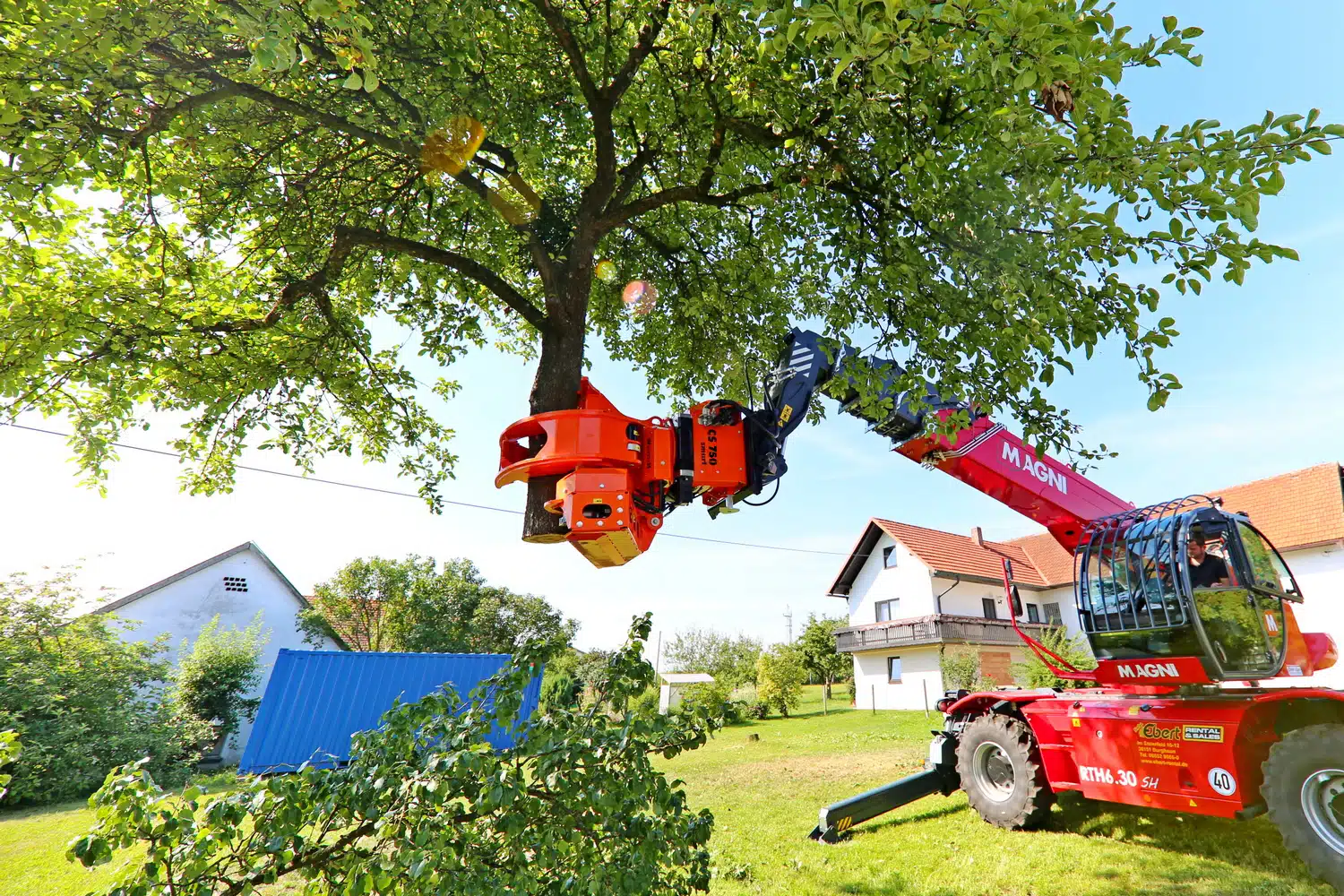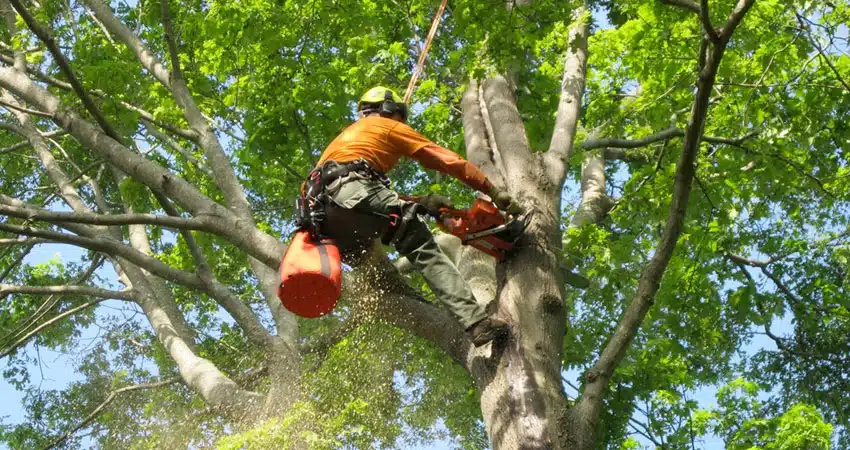Trimming arborvitae trees is vital for maintaining their health, shape, and overall look. Proper pruning improves their aesthetic appeal and encourages vigorous growth and durability. In this comprehensive guide, we will look at how to trim arborvitae trees, the strategies, ideas, and best practices for cutting arborvitae trees successfully.
Overview of the Arborvitae Tree
Arborvitae trees, which belong to the genus Thuja, are known for their lush foliage and graceful, conical shape. Landscapers value these evergreens for their adaptability and resilience in a various climates. Arborvitae trees typically grow between 10 and 200 feet tall, depending on the species, and have scale-like leaves that remain vivid green all year. Arborvitae trees commonly create small, cone-shaped structures that hold their seeds, serving as privacy screens, windbreaks, or decorative accents in gardens and parks. Arborvitae trees require little maintenance once established, preferring well-drained soil and full sun to partial shade. Arborvitae trees are popular among homeowners and landscapers due to their beautiful appearance and practical functions.
Why trim arborvitae trees?

Improving aesthetic appeal and health
Proper trimming helps arborvitae trees maintain their original shape, preventing them from becoming overgrown or disfigured. Remove dead or damaged branches to improve their look while lowering the danger of fungal infections and pest infestations. This improves overall tree health and vitality.
Encourage growth and density
Strategic pruning promotes new growth and increases the density of arborvitae leaves. By cutting strategically, you let sunshine and air reach deeper into the canopy, promoting the growth of lush, green foliage throughout the tree.
When to trim an arborvitae tree?
It is best to trim arborvitae trees in late winter or early spring before new growth begins. This dormant phase reduces stress on the tree and facilitates fthe fasterhealing of pruning wounds. Avoid pruning in the autumn because it can expose the tree to frost damage or winter burns.
When they are young, prune arborvitae tree
Many gardeners like to prune arborvitae in early spring, using the same schedule as deciduous trees. However, cutting conifers during their dormant season is not advisable. Arborvitae are best trimmed between late summer and early autumn. Another appropriate time is late spring, when the new spring growth has developed. If your arborvitae are young and growing rapidly, biannual pruning may be advantageous. It is critical to avoid pruning during the hottest summer days and dormant winter months. By carefully timing your trimming procedures, you can promote healthy development and keep your arborvitae trees looking good all year.
How to trim arborvitae tree?
Arborvitae trees require proper trimming to maintain their health, shape, and attractiveness. This step-by-step lesson describes how to clip angles for effective pruning.
Observe the tree
Before commencing the pruning process, thoroughly inspect the arborvitae tree. Identify and remove any dead, diseased, or crossing branches. This initial examination aids in determining where to make cuts while ensuring the tree’s health.
Gather the right tools
Prepare the pruning equipment, which includes
- Pruning shears
- Loppers
- Handsaw for larger branches.
Make sure all equipment is sharp and clean for precise cuts that promote speedy healing and reduce stress on the tree.
Cutting Techniques.
45-Degree Angle Cuts: Always trim branches at a 45-degree angle, right above a bud or lateral branch. This angled cut allows water to drain from the wound and promotes new growth in the desired direction.
Avoid Flush Cuts: Flush cuts (totally straight cuts) can impair the tree’s capacity to repair properly. Angled cuts promote callus production, which heals the wound more efficiently.
Directional Pruning
Selective branch removal prioritizes the removal of dead, damaged, or diseased branches. Locate and remove branches that are crossing or rubbing against one another, as they can cause sores and attract bugs or diseases.
Maintain the arborvitae tree’s natural shape, and trim softly across the canopy. Focus on contouring rather than severely lowering size, as excessive pruning can stress the tree and harm its overall health.
Cleanup and maintenance
After pruning, pick up any debris at the tree’s base to keep pests and illnesses from hiding in the rotting material.
Encouraging regrowth of arborvitae tree
Pruning arborvitae trees properly and at the right time is essential to promoting regeneration. Begin by trimming gently, focusing on clipping back new shoots that are more than an inch (2.5 cm) long to promote lateral development. Prune the trees in late spring or early autumn to reduce stress and stimulate vigorous new growth. To preserve shape and density, prune once to twice a year. Additionally, make sure the trees get enough water and nutrients, especially after pruning. A balanced fertilizer can replace soil minerals and promote healthy regrowth, resulting in lush, vibrant arborvitae trees.
Related Posts:
Arborvitae hedge trimming rules
For pruning an arborvitae hedge, there are seven important rules.
Begin pruning soon after planting, when the arborvitae have set roots and are showing new growth.
Trim lightly, focusing on new shoots longer than an inch (2.5 cm).
Trim to promote the development of lateral shoots, which aids in the creation of a dense hedge.
Trim one to two times each year to maintain the correct shape and density.
Heavy trimming can stress the hedge and impede its growth.
Pruning in late spring or early autumn promotes healthy growth and reduces stress.
Use sharp pruning shears for precise cuts, and keep instruments clean to prevent disease transmission.
Following these guidelines will help keep your arborvitae hedge healthy, dense, and visually appealing year-round.
FAQs
How frequently should I prune my arborvitae hedge?
For best results, prune your arborvitae hedge once to twice a year. Regular pruning helps to keep it in shape and supports healthy development.
After pruning, should I fertilize my arborvitae trees?
After trimming, apply a balanced fertilizer to promote healthy regrowth and replenish soil nutrients.
Can I trim my arborvitae hedge to a specific shape?
Pruning arborvitae hedges can create various shapes, such as cones, pyramids, and rectangular forms. Regular, mild trimming helps to develop and keep the desired form.
Can I prune arborvitae trees during their dormant season?
We do not recommend pruning arborvitae trees during their dormant period, as it can cause stress to the tree. The best time to prune is when the tree is actively growing.
Conclusion
Trimming arborvitae trees is an important part of keeping them healthy and increasing their visual value in your garden. By using proper trimming techniques and timing, you can ensure that your arborvitae trees thrive all year. Whether you’re designing a hedge or caring for individual trees, starting early and trimming softly is essential for encouraging dense growth and structural stability. To reduce stress on the trees, remember to use sharp, clean equipment and avoid pruning during harsh weather conditions. Regular maintenance, including one to two cuts each year, will make your arborvitae trees look their best while benefiting your outside environment. Arborist River Oaks can provide expert guidance and assistance with arborvitae tree maintenance, ensuring the best results and long-term health.





